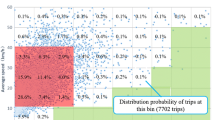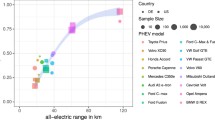Abstract
Both China’s national subsidy policies for plug-in electric vehicles (PEVs) purchasers and passenger cars corporate average fuel consumption and new vehicle credit regulation (dual-credit policy) favor long-range 300+ km battery electric vehicles (BEVs) and 80+ km plug-in hybrid electric vehicles (PHEVs). However, these electric vehicles tend to have lower energy efficiency and higher purchase and operation costs. Vehicle with larger batteries can also be less equitable because the subsidies are often provided to more expensive vehicles and wealthier owners. This study takes advantage of a novel dataset of daily driving data from 39,854 conventional gasoline vehicles in Beijing and 4999 PHEVs in Shanghai to determine the optimal range of BEVs and PHEVs within their respective cities. We simulate a model to explore ranges with which PEVs emit less GHGs than that of a baseline hybrid and conventional gasoline vehicle while ensuring that all daily travel demands are met. Our findings indicate that in both cities, the optimal ranges to balance cost and travel demand for BEVs are 350 km or less and for PHEVs are 60 km or less in Beijing and 80 km or less in Shanghai. We also find that to minimize carbon dioxide (CO2) emissions, the ranges are even lower 10 km in Beijing and 30 km in Shanghai. Our study suggests that instead of encouraging long-range PEVs, governments should subsidize PEV models with shorter ranges. Parallel efforts should also be made to both increase renewable energy over fossil fuels and expand charging facilities. Although individual mobility demand varies, the government could reduce occasional long-distance driving by subsidizing alternative transportation choices. Providing week-long driving trials to consumers before their purchases may help decrease the demand of very long range PEVs by alleviating the range anxiety through a learning process.







Similar content being viewed by others
References
Berjoza D, Jurgena I (2017) Influence of batteries weight on electric automobile performance. Eng Rural Dev:24–26
Cheah LW (2010) Cars on a diet: the material and energy impacts of passenger vehicle weight reductin in the U.S. (Ph D), Massachusetts institute of technology
China Clean Transportation Partnership (2018) Projects: EV-TEST tells you the real performance of EVs in China
China Passenger Car Association (2018) The sales of PHEV models. Retrieved from http://biz.touchev.com/industry_data
EV Adoption (2018) US BEV Battery Range Increases an Average 17% Per Year and 38 Miles Each Model Update Retrieved from https://evadoption.com/us-bev-battery-range-increases-an-average-17-per-year-and-38-miles-each-model-update/
Kontou E, Yin Y, Lin Z (2015) Socially optimal electric driving range of plug-in hybrid electric vehicles. Transp Res Part D: Transp Environ 39:114–125
Lin Z (2012) Optimizing and diversifying the electric range of plug-in hybrid electric Vehciles for U.S. drivers. SAE Int J Alt Power 1:180–194
Lin Z (2014) Optimizing and diversifying electric vehicle driving range for U.S. drivers. Transp Sci 48:635–650
Ministry of Industry and Information Technology (2015) Passenger car fuel comsumption explanation [Press release]. Retrieved from Ministry of Industry and Information Technology (MIIT)
National Big Data Aliance of New Energy Vehicles (NDANEV) (2019) New energy vehicle 2019 Spring Festival Travel Season big data report https://www.3mbang.com/p-4705829.html
National Center for Climate Change Strategy and International Cooperation (NCSC) (2016) Province level average power grid CO2 emission factor
Nichols, J (2019) Poll finds Americans feel electric vehicles are the future of driving [Press release]. Retrieved from https://www.media.volvocars.com/us/en-us/media/pressreleases/248305/poll-finds-americans-feel-electric-vehicles-are-the-future-of-driving
Pearre NS, Kempton W, Guensler RL, Elango VV (2011) Electric vehicles: how much range is required for a day's driving? Transp Res C. https://doi.org/10.1016/j.trc.2010.12.010
Plötz P, Funke SA, Jochem P, Wietschel M (2017) CO2 mitigation potential of plug-in hybrid electric vehicles larger than expected. Sci Rep 7:1–6
Shiau CSN, Michalek JJ (2010) Optimal plug-in hybrid electric vehicle design and allocatgion for minimum life cycle cost. J Mech Des 133(9)
Society of Automobile Engineers (SAE) (1999) Recommended practice for measuring the exhaust emissions and fuel economy of hybrid-electric vehicles. SAE-J1711. Retrieved from https://saemobilus.sae.org/content/j1711_201006
Society of Automobile Engineers (SAE) (2009) Utility factor definitions for plug-in hybrid electric vehicles using 2001 U.S. DOT National Household Travel Survey data. Hybrid Committee, SAE-J2841. Retrieved from https://saemobilus.sae.org/content/j2841_200903
Tal G, Nicholas M, Davis J, Woodjack J (2014) Charging behavior impacts on electric VMT: who is not plugging in? Transp Res Rec 2454:53–60
Wang, H (2017) Significant CO2 emission reduction from new energy vehicles. Retrieved from https://www.d1ev.com/kol/51461
Wu X, Aviquzzaman M, Lin Z (2015) Analysis of plug-in hybrid electric vehicles utility factors using GPS-based longitudinal travel data. Transp Res C 57:1–12
Xia Y, Yang J, Wang F, Cheng Q (2018) Impact of battery size and energy cost on the market acceptance of blended plug-in hybrid electric vehicles. Procedia Comput Sci 131:377–386
Yuan X, Li L, Gou H, Dong T (2015) Energy and environmental impact of battery electric vehicle range in China. Appl Energy 157:75–84
Yuksel T, Michalek JJ (2015) Effects of regional temperature on electric vehicle efficiency, range, and emissions in the United States. Environ Sci Technol 49:3974–3980
Zhang X, Wang H (2014) Utility factors derived from Beijing passenger car travel survey. Paper presented at the FISITA 2014 World automotive congress Maastricht, Netherlands
Author information
Authors and Affiliations
Corresponding author
Additional information
Publisher’s note
Springer Nature remains neutral with regard to jurisdictional claims in published maps and institutional affiliations.
SI: PEV technology and market assessment for the United States and China
Rights and permissions
About this article
Cite this article
Xing, Y., Jenn, A.T., Wang, Y. et al. Optimal range of plug-in electric vehicles in Beijing and Shanghai. Mitig Adapt Strateg Glob Change 25, 441–458 (2020). https://doi.org/10.1007/s11027-020-09912-7
Received:
Accepted:
Published:
Issue Date:
DOI: https://doi.org/10.1007/s11027-020-09912-7




